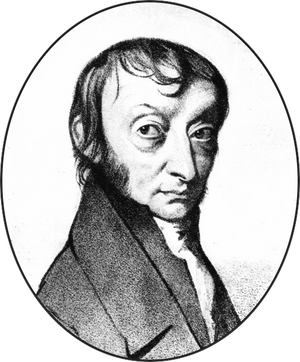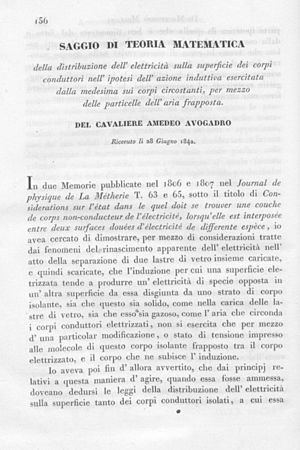Amedeo Avogadro facts for kids
Quick facts for kids
Amedeo Avogadro
|
|
|---|---|
 |
|
| Born |
Amedeo Carlo Avogadro
9 August 1776 |
| Died | 9 July 1856 (aged 79) |
| Nationality | Italian |
| Known for | Avogadro's law Avogadro constant |
| Scientific career | |
| Fields | Chemistry |
| Institutions | University of Turin |
| Signature | |
Amedeo Avogadro (born August 9, 1776 – died July 9, 1856) was an important Italian scientist. He is best known for his work on how gases behave. His most famous idea is called Avogadro's law. This law says that if you have equal amounts of different gases, and they are at the same temperature and pressure, they will have the same number of tiny particles called molecules.
In his honor, a very important number in chemistry is named the Avogadro constant. This constant helps scientists count the huge number of atoms or molecules in a substance. It is a key part of the SI (the system of measurement used worldwide).
Contents
Amedeo Avogadro's Life Story
Amedeo Avogadro was born in Turin, which was then part of the Kingdom of Sardinia. This was in the year 1776. He came from a noble family.
When he was 20, he finished his studies in church law. But soon after, he became very interested in physics and mathematics. In 1809, he started teaching these subjects. He taught at a high school in Vercelli, where his family lived.
In 1811, Avogadro published an important paper. It was about how to figure out the weights of tiny particles (molecules) and how they combine. This paper introduced what we now call Avogadro's hypothesis.
In 1820, he became a professor of physics at the University of Turin. He taught there for a few years. He was involved in some political changes happening in Italy at the time. Because of this, he lost his teaching job in 1823. The university said he was "resting from heavy teaching duties" to focus on his research.
However, Avogadro was called back to the University of Turin in 1833. He continued teaching there for another twenty years.
Not much is known about Avogadro's personal life. He was a quiet and religious person. He married Felicita Mazzé and they had six children. He also worked in other areas, like statistics and weather. He helped bring the metric system to Piedmont, a region in Italy.
Amedeo Avogadro passed away on July 9, 1856.
Avogadro's Scientific Discoveries
Avogadro made huge contributions to our understanding of chemistry.
The Avogadro Constant
To honor Avogadro, the number of molecules in one mole of a substance is called the Avogadro constant, or NA. This number is incredibly large: about 6.022 x 1023.
This constant is super useful for chemists. It helps them calculate how much of a substance is made or used in chemical reactions. It allows for very accurate measurements in chemistry.
A scientist named Johann Josef Loschmidt was the first to calculate the value of this constant.
Avogadro's Law Explained
Avogadro's law is his most famous idea. It states that if you have different gases, and they are all at the same temperature and pressure, then equal volumes of these gases will contain the same number of molecules.
This law helps scientists figure out the relative weight of gas molecules. You can calculate a gas's molecular weight by knowing the weight of a certain amount of that gas.
Avogadro came up with this idea after Joseph Louis Gay-Lussac published his law about gas volumes in 1808.
Atoms and Molecules
One of Avogadro's biggest achievements was clearly explaining the difference between atoms and molecules. Before him, many scientists, like John Dalton, often confused them.
Avogadro explained that gases are made of molecules. These molecules, in turn, are made up of atoms. For example, an oxygen molecule (O2) has two oxygen atoms joined together. This idea was very important for the future of chemistry.
He also paid close attention to the definition of mass, which is different from weight.
See also
 In Spanish: Amedeo Avogadro para niños
In Spanish: Amedeo Avogadro para niños
- Avogadrite (mineral)
- Avogadro (lunar crater)



